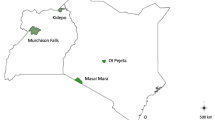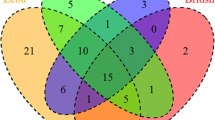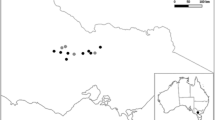Abstract
The evolution ofMHC polymorphism has been studied by comparing the amino acid and nucleotide sequences of 14 bovine and 32 humanDRB alleles. The comparison revealed an extensive sharing of polymorphic sequence motifs in the two species. Almost identical sets of residues were found at several highly polymorphic amino acid positions in the putative antigen recognition site. Consequently, certain bovine alleles were found to be more similar to certain human alleles than to other bovine alleles. In contrast, the frequencies of silent nucleotide substitutions were found to be much higher in comparisons between species than within species implying that none of the human or bovine DRB alleles originated before the divergence of these distantly related species. The results suggest that the observed similarity inDRB polymorphism is due to convergent evolution and possibly the sharing of short ancestral sequence motifs. However, the relative role of the latter mechanism is difficult to assess due to the biased base composition in the first domain exon of polymorphic class 11 β genes. The frequency of silent substitutions betweenDRB alleles was markedly lower in cattle than in man suggesting that theDRB diversity has evolved more rapidly in the former species.
Similar content being viewed by others
References
Bodmer, W. F.: The evolutionary significance of theHLA system.Nature 237: 139–145, 1972
Brown, J. H., Jardetzky, T., Saper, M. A., Samraoui, B., Bjorkman, P. J., and Wiley, D. C.: A hypothetical model of the foreign antigen binding site of class II histocompatibility molecules.Nature 332: 845–850, 1988
Figueroa, F., Günther, E., and Klein, J.: MHC polymorphism predating speciation.Nature 335: 265–267, 1988
Goodman, M., Romero-Herrera, A. E., Dene, H., Czelusniak, J., and Tashian, R. E.: Amino acid sequence evidence on the phylogeny of primates and other Eutherians.In M. Goodman (ed.):Macromolecular Sequences in Systematic and Evolutionary Biology, pp. 115–191, Plenum, New York, 1982
Gustafsson, K., Germana, S., Hirsch, F., Pratt, K., LeGuern, C., and Sachs, D. H.: Structure of miniature swine class II DRB genes: conservation of hypervariable amino acid residues between distantly related mammalian species.Proc Natl Acad Sci USA 87: 9798–9802, 1990a
Gustafsson, K., LeGuern,C., Germana, S., Hirsch, F., Pratt, K., and Sachs, D. H.: Class II genes of miniature swine IV. Characterization and expression of two allelic class II DQB cDNA clones.J Immunol 145: 1946–1951, 1990b
Gyllensten, U. B., Lashkari, D., and Erlich, H. A.: Allelic diversification at the class II DQB locus of the mammalian major histocompatibility complex.Proc Natl Acad Sci USA 87: 1835–1839, 1990
Hughes, A. L. and Nei, M.: Nucleotide substitutions at major histocompatibility complex class II loci: evidence for overdominant selection.Proc Natl Acad Sci USA 86: 958–962, 1989
Irwin, D. M., Kocher, T. D., and Wilson, A. C.: Evolution of the cytochromeb gene of Mammals.J Mol Evol In press, 1990
Jukes, T. H. and Cantor, C. R.: Evolution of protein molecules.In H. N. Munro (ed.):Mammalian Protein Metabolism, pp. 21–132, Academic Press, New York, 1969
Klein, J.: Generation of diversity at MHC loci: Implications for T-cell repertoires.In K. Fougereau and J. Dausset (eds.):Immunology 80, pp. 239–253, Academic Press, London, 1980
Klein, J.: Natural History of the Major Histocompatibility Complex, John Wiley & Sons, New York, 1986
Klein, J.: Origin of major histocompatibility complex polymorphism: the trans-species hypothesis.Hum Immunol 19: 155–162, 1987
Lawlor, D. A., Ward,F. E., Ennis,P. D.Jackson, A. P., and Parham, P.:HLA-A andB polymorphisms predate the divergence of humans and chimpanzees.Nature 335: 268–271, 1988
Marsh, S. G. E. and Bodmer, J. G.: HLA-DR and -DQ epitopes and monoclonal antibody specificity.Immunol Today 10: 305–312, 1989
Marsh, S. G. E. and Bodmer, J. G.: HLA-DRB nucleotide sequences, 1990.Immunogenetics 31: 141–144, 1990
Mayer, W. E., Jonker, M., Klein, D., Ivanyi, P., van Seventer, G., and Klein, J.: Nucleotide sequences of chimpanzee MHC class I alleles: evidence for trans-species mode of evolution.EMBO J 7: 2765–2774, 1988
McConnell, T. J., Talbot, W. S., McIndoe, R. A., and Wakeland, E. K.: The origin of MHC class II gene polymorphism within the genus Mus.Nature 332: 651–654, 1988
Nei, M. and Gojobori, T.: Simple methods for estimating the numbers of synonymous and nonsynonymous nucleotide substitutions.Mol Biol Evol 3: 418–426, 1986
Nei, M. and Jin, L.: Variances of the average numbers of nucleotide substitutions within and between populations.Mol Biol Evol 6: 290–300, 1989
Parham, P., Lawlor, D. A., Lomen, C. E., and Ennis, P. D.: Diversity and diversification of HLA-A,B,C alleles.J Immunol 142: 3937–3950, 1989
Sarmiento, U. M., Sarmiento, J. L, and Storb, R.: Allelic variation in the DR subregion of the canine major histocompatibility complex.Immunogenetics 32: 13–19, 1990
Sidow, A. and Wilson, A. C.: Compositional statistics: an improvement of evolutionary parsimony and its applications to deep branches of the tree of life.J Mol Evol 31: 51–68, 1990
Sigurdardóttir, S., Lundén, A., and Andersson, L.: Restriction fragment length polymorphism ofDQ andDR class II genes of the bovine major histocompatibility complex.Anim Genet 19: 133–150, 1988
Sigurdardôtti, S., Borsch, C., Gustafsson, K., and Andersson, L.: Cloning and sequence analysis of 14DRB alleles of the bovineMHC by using the polymerase chain reaction.Anim Genet 22 : in press, 1991
Takahata, N. and Nei, M.: Allelic genealogy under overdominant and frequency-dependent selection and polymorphism of major histocompatibility complex loci.Genetics 124: 967–978, 1990
Wakeland, E. K., Boehme, S., and She, J. X.: The generation and maintenance ofMHC class II gene polymorphism in rodents.Immunol Rev 113: 207–226, 1990
Zinkernagel, R. M. and Doherty, P. C.: MHC-restricted T cells: studies on the biological role of the polymorphic major transplantation antigens determining T-cell restriction-specificity, function, and responsiveness.Adv Immunol 27: 221–292, 1979
Author information
Authors and Affiliations
Rights and permissions
About this article
Cite this article
Andersson, L., Sigurdardóttir, S., Borsch, C. et al. Evolution ofMHC polymorphism: Extensive sharing of polymorphic sequence motifs between human and bovine DRB alleles. Immunogenetics 33, 188–193 (1991). https://doi.org/10.1007/BF01719239
Revised:
Accepted:
Issue Date:
DOI: https://doi.org/10.1007/BF01719239




